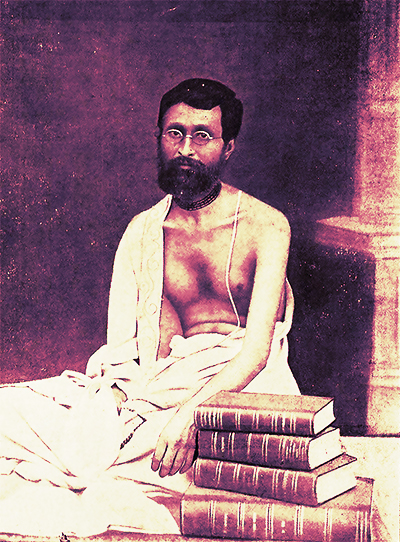śrī śrī guru gaurāṅga jayataḥ!

Year 10, Issue 3
Posted: 16 April 2017
Dedicated to
nitya-līlā praviṣṭa oṁ viṣṇupāda
Śrī Śrīmad Bhakti Prajñāna Keśava Gosvāmī Mahārāja
Inspired by and under the guidance of
nitya-līlā praviṣṭa oṁ viṣṇupāda
Śrī Śrīmad Bhaktivedānta Nārāyaṇa Gosvāmī Mahārāja
How the Holy Name Blooms
Into Kṛṣṇa’s Beautiful Form

According to the doctrine of Śrī Caitanya Mahāprabhu and to the decision of the six Divine Gosvāmis of Śrī Vṛndāvana and their associate Gosvāmīs, śrī nāma-saṅkīrtana (the chanting of God’s names) is our main service to God. Without the grace of śrī nāma, God’s pastimes cannot be awakened in the hearts of men. With the gradual unfolding of the blossom of śrī nāma, which is replete with the totality of transcendent, delicious rasa, the holy Name finally evolves into God’s fascinating beautiful form – sat-cit-ānanda Śrī Śyāmasundara of the transcendental region of Goloka Vṛnḍavana – and so forth.
Within the opening blossom of the holy Name, the practitioner experiences the fragrance of Kṛṣṇa’s sixty-four attributes just like the sweet smell of a flower. The heart of one who is ever engaged in śrī nāma saṅkīrtana becomes illuminated with truly pure and virtuous spiritual goodness. And when the flower of śrī nāma fully opens within such a pure heart, the divine Couple appear there, engaged in Their transcendentally amorous sports during the eight phases of day and night. Those playful pastimes are eternal and beyond material nature.*
________________
* C.f. aṣṭa-kālīya-līlā
Any attempt to meditate upon such pastimes separate from kīrtana is tantamount to aspiring for material honour and celebrity. There are many who, although learned in the Sanskrit works of the Gosvāmīs, have no access to the Gosvāmīs’ true conclusions. This is because they lack attachment to those who are truly learned and because they have never had access to the Bengali scripture, Śrī Caitanya-caritāmṛta of Śrīla Kavirāja Gosvāmī, which contains the true essence of all the Sanskrit works of the Gosvāmīs like the Ṣat-sandarbhas of Śrī Jīva Gosvāmī, the Bhāgavatamṛta of Śrīla Sanātana Gosvāmī and the works of Śrī Rūpa Gosvāmī.
The chanting of artificially composed, cheap verses is not śrī nāma saṅkīrtana; it is simply kīrtana of nāmāparādha, or a serious offence in the garb of śrī nāma. It does not lead to gratifying Kṛṣṇa’s senses nor to becoming engaged in serving Him. Rather, it amounts to the gratification of one’s own material senses; that is to say, it leads only to mundane enjoyment and spiritual offence. Real bhajana (transcendental worship of and service to God) consists of the saṅkīrtana of śrī nāma as uttered by Śrī Caitanyadeva. It is that alone which is able to generate the affluence of love and has been ascertained by all holy saints to be the best form of bhajana.
The self-manifesting nectar of nāma, appearing upon a single sense organ (the tongue) which eagerly offers service, overwhelms the entire group of senses, flooding them with its own sweet succulence. Śrī Kavirāja Gosvāmī Prabhu has sung this truth (in his Caitanya-caritāmṛta) thus: “Among all forms of bhajana, the nine kinds of bhakti (śravaṇa, kīrtana, smaraṇa, etc.) are the best, exercising great power, as they do, to give love of Kṛṣṇa; which is to say, they give Kṛṣṇa Himself. And among these nine, nāma-saṅkīrtana is the best of all. If one takes to the chanting of śrī nāma without committing any spiritual offence, one attains the wealth of prema (love of God).”
Śrī Jīva Gosvāmīpāda has said (in the Ṣat-sandarbhas):
“In Kali-yuga, people are, by nature, spiritually poor. The form of bhakti known as kīrtana appears among them of its own accord and makes them blessed, easily giving them all the good results of the greatly difficult practices and performances of the previous yugas. In this Kali-yuga, God is so pleased with saṅkīrtana alone. If, in Kali-yuga, other limbs of bhakti are to be cultured, it must be done in association with kīrtana.
“So it has been said (in Śrīmad-Bhāgavatam 11.5.32) that the Kali-yuga āvatāra (Śrī Caitanyadeva) is worshipped by truly learned and wise men with offerings of saṅkīrtana. Among those offerings, kīrtana of unmixed, pure nāma is singularly commendable (especially to the exclusion of concocted songs about the form and pastimes of the Lord that are composed for the gratification of the material senses of unworthy singers and their audiences). ‘Only harināma is to be repeatedly chanted, for there is no other course in Kali-yuga for blessedness.’ This has been repeatedly impressed upon us (in the Bṛhan Nāradīya Purāṇa).”
There are very authentic proofs in the Purāṇas to show the extreme need of performing exclusive kīrtana of such unmixed, pure names as just described.
Adapted from The Gaudiya Volume 5, Number 4
by the Rays of The Harmonist team
![]()





